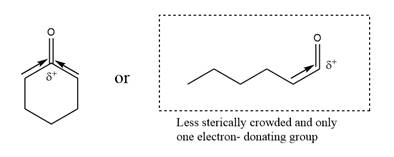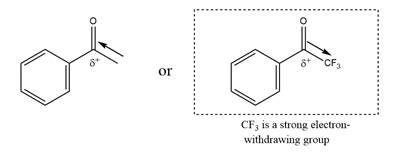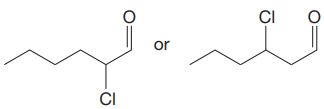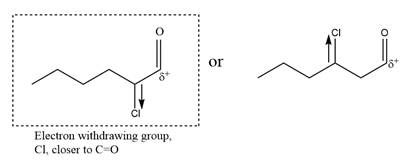
(a)
Interpretation:
Among the given pair of compounds, which compound has the polar pi bond that will undergo nucleophilic addition more rapidly is to be identified and explained.
Concept introduction:
A Nucleophilic addition reaction involves a polar
Answer to Problem 17.34P
Among the given pair of compounds, the second compound has the polar pi bond that will undergo nucleophilic addition more rapidly than the first one. This is because with fewer alkyl groups attached to the carbonyl carbon, there is less bulkiness and greater concentration of positive charge.
Explanation of Solution
The given pair of compounds are

The electron-donating groups attached to the carbonyl carbon will decrease the concentration of the positive charge on the carbonyl carbon atom. In the first compound, the carbonyl carbon has two electron-donating substituents attached. In the second compound, the carbonyl carbon has only one electron-donating substituent attached. The partial positive charge on the carbonyl carbon of the second compound is greater as compared to the first one. This makes the carbonyl carbon of the second compound more electrophilic, thus, it will have more polar pi bond. Due to this, it will undergo nucleophilic addition reactions more rapidly. Due to fewer alkyl groups attached in the second compound, there is less bulkiness and hence greater contribution of a positive charge.

Electron-donating groups directly attached to the carbonyl carbon will decrease the concentration of a partial positive charge and make the pi bond less polar.
(b)
Interpretation:
Among the given pair of compounds, which compound has the polar pi bond that will undergo nucleophilic addition more rapidly is to be identified and explained.
Concept introduction:
A Nucleophilic addition reaction involves a polar
Answer to Problem 17.34P
Among the given pair of compounds, the second one has a more polar pi bond that will undergo nucleophilic addition more rapidly than the first one. This is because a substituent -
Explanation of Solution
The given pair of compounds are

The electron-withdrawing groups attached to the carbonyl carbon will increase the concentration of the positive charge on the carbonyl carbon atom. In the first compound, the carbonyl carbon has a benzene ring at one end, and a

Electron-withdrawing groups directly attached to the carbonyl carbon will induce a greater concentration of a partial positive charge and make the pi bond more polar.
(c)
Interpretation:
Among the given pair of compounds, which compound has the polar pi bond that will undergo nucleophilic addition more rapidly is to be identified and explained.
Concept introduction:
A Nucleophilic addition reaction involves a polar
The concentration of the positive charge on the carbonyl carbon increases as the distance between an electron-withdrawing atom or group and the carbonyl carbon decreases.
Answer to Problem 17.34P
Among the given pair of compounds, the first one has more polar pi bond that will undergo nucleophilic addition more rapidly than the second one. This is because with the chlorine atom closer to the carbonyl carbon, the carbonyl carbon will bear a greater concentration of positive charge.
Explanation of Solution
The given pair of compounds are

Among the given pair of compounds, the first one has more polar pi bond that will undergo nucleophilic addition more rapidly than the second one. This is because with the chlorine atom closer to the carbonyl carbon, the carbonyl carbon bears a greater concentration of positive charge. The partial positive charge on the carbonyl carbon of the first compound is greater as compared to the second one. This makes the carbonyl carbon of the first compound more electrophilic, thus, it will have more polar pi bond. Due to this, it will undergo nucleophilic addition reactions more rapidly.

The concentration of the positive charge on the carbonyl carbon increases as the distance between an electron-withdrawing atom or group and the carbonyl carbon decreases.
(d)
Interpretation:
Among the given pair of compounds, which compound has the polar pi bond that will undergo nucleophilic addition more rapidly is to be identified and explained.
Concept introduction:
A Nucleophilic addition reaction involves a polar
Explanation of Solution
The given pair of compounds are:
![]()
Among the given pair of compounds, the first one has more polar pi bond that will undergo nucleophilic addition more rapidly than the second one. This is because the nitrile carbon bears a higher concentration of positive charge owing to the presence of the electron-withdrawing


Electron-withdrawing groups directly attached to the pi bond will induce a greater concentration of a partial positive charge and makes the pi bond more polar.
[DK1]
Want to see more full solutions like this?
Chapter 17 Solutions
ORG.CHEM W/TEXT+SOLU.MANUAL
- Rank from slowest to fastest (in order of increasing nucleophilicity)arrow_forwardFor each pair of aromatic compounds, determine which will undergo electrophilic aromatic substitution faster. E,F,G,H onlyarrow_forwardwhich of the aromatic ring has the fastest rate of reaction for an electrophilic aromatic substitution reaction:arrow_forward
 Organic Chemistry: A Guided InquiryChemistryISBN:9780618974122Author:Andrei StraumanisPublisher:Cengage Learning
Organic Chemistry: A Guided InquiryChemistryISBN:9780618974122Author:Andrei StraumanisPublisher:Cengage Learning
